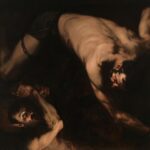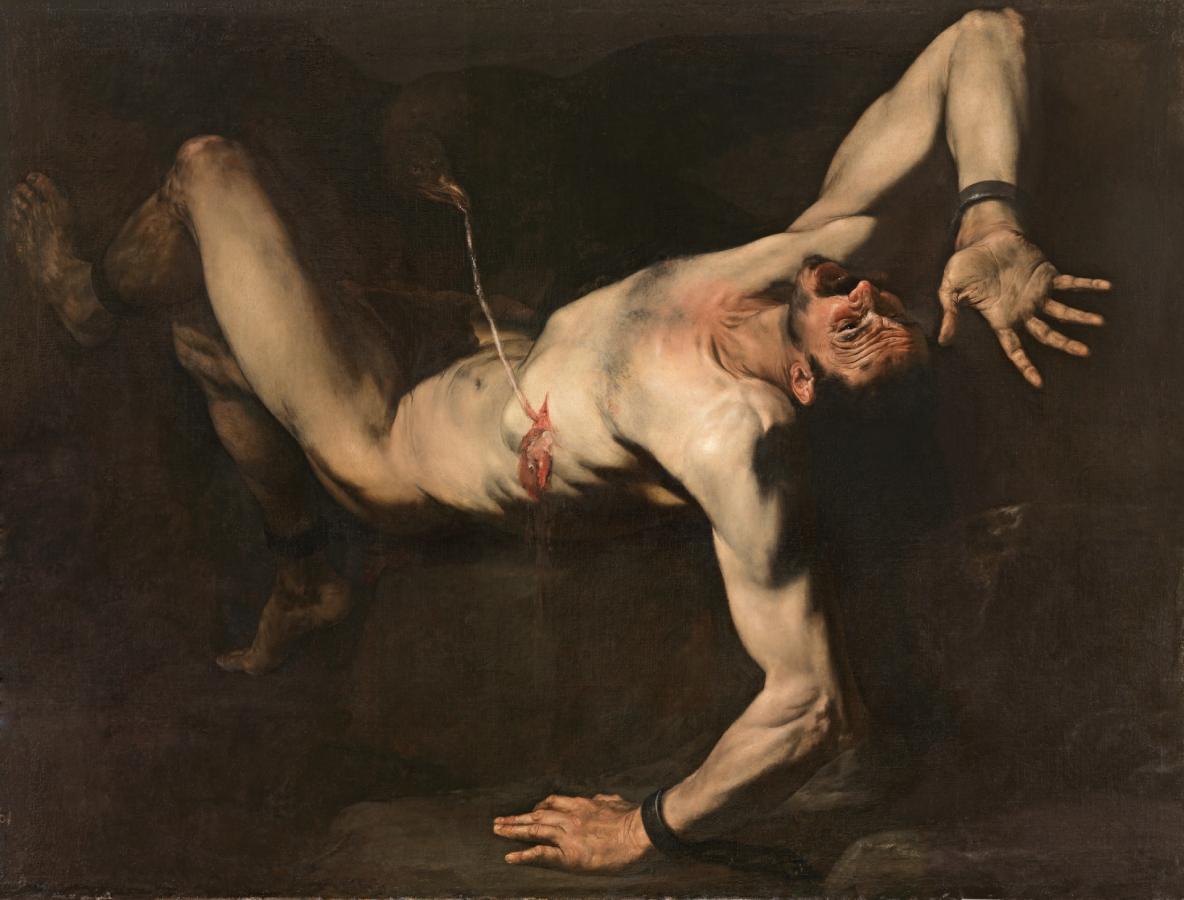Ribera, Jusepe de (1591-1652)
Tizio (Tityus)
1632
Oil on canvas, 227 × 301 cm
Museo del Prado, Madrid
Tityus, the son of Jupiter and Elara, appears chained to the boulder in Tartarus while an eagle eternally devours his liver. The Giant received that punishment for attempting to rape one of his father’s lovers with the encouragement of Juno. The subject of the Furies -Tityus, Ixion, Tantalus and Sisyphus- became quite popular in European art of the Modern Age, especially in palace decorations. These figures were interpreted as representing the implacable power of the reigning dynasty in the face of the unfaithfulness, pride and arrogance of those who opposed the supremacy of the Monarchy. Ribera probably knew prints of the so-called Furies of the Alcázar of Madrid, which Titian had painted for Marie of Hungary with the same plot and subject. This type of composition allowed the artist to make large works with monumental forms that, in this case, were well suited to Ribera’s strong and powerful style.
It was probably this work (the corresponding letter of payment actually mentions an Ysion and a Sísifo, but the latter may be a simple error) that was acquired alongside Ixion in Madrid in 1634 from the Marchioness of Charela, grandmother of one of the king’s illegitimate sons. The purchaser was Jerónimo de Villanueva, pro-notary of Aragon, and the works were intended as decoration for the Buen Retiro Palace. The letter of payment explains only how the paintings were purchased, without excluding the possibility that they were commissioned directly from the artist in Naples for the king. In fact, the combination of subjects represented and the enormous dimensions of these works make it unlikely that they were anything other than a royal commission. We know that paintings by Ribera were already in the Royal Collection in 1630, as Philip IV greatly admired his work. And, while these were very probably part of a series of four, nothing is known of the other two.
Tityus and Ixion are endowed with extraordinary visual force and compositional creativity, and they are impressive and frightful in equal measure. Depicted considerably larger than life, Tityus lies face up, waving his limbs like a windmill with his face contorted in an unending cry of agony while the eagle rips out his entrails through a gash in his side. The head leaned back, deeply wrinkled forehead and open mouth reappear in two famous later depictions of Apollo and Marsyas, from 1637, which also address the punishment of arrogance (Naples, Museo Nazionale di Capodimonte, and Brussels, Musées Royaux des Beaux-Arts). Tityus’s posture is based on Titian’s Tantalus, one of the two Furies missing from the series that Ribera would have known through the print by Giulio Sanuto from around 1565. Here, however, Ribera audaciously inverts the figure’s diagonal orientation so that his legs extend towards the darkness of hell while his upper torso, head and arms project violently into the viewer’s space.
The numbers 800 and 801, painted in white on Ixion and Tityus, respectively, correspond to the numeration of the Buen Retiro Palace’s 1794 inventory. We can therefore deduce with some degree of confidence that both works reached the Buen Retiro in 1634 and remained there uninterruptedly until the late 18th century, entering the Museo del Prado soon thereafter (Text drawn from Portús, J.: Pintura barroca española. Guía, Museo Nacional del Prado, 2001, pp. 84-86; Finaldi, G.: El Palacio del Rey Planeta. Felipe IV y el Buen Retiro, Museo Nacional del Prado, 2005, pp. 236-237).
Pair:
 Ribera, Jusepe de (1591-1652)
Ribera, Jusepe de (1591-1652)
Issione
1632
Museo del Prado, Madrid
